How to make a seed bomb? Instructions in English
This kit contains

1 bag of BIO* honey mix seeds

1 bag of green clay powder

1 bag of natural fertilizer

1 peat of soil
*Organic certified seeds. Composition: 25% Phacelia, 15% Buckwheat, 9% Crimson clover, 8% Alexandria clover, 7% Serradella, 7% Caraway, 5% Mustard, 5% Coriander, 5% Calendula, 5% Cultivated Camelina, 3% Oleander Radish, 2% Dill, 2% Fennel, 1% Sunflower, 1% Woodland Mallow.
Suitable for children from 6 years old under supervision.
Instructions

1. Place the peat in lukewarm water. Wait until it is all absorbed.

2. Add clay, fertilizer and mix.

3. Add water gradually to obtain a homogeneous paste, similar to a modelling clay.

4. In the palm of your hand, form balls measuring about 2 cm to 3 cm in diameter.

5. Use your finger to dig a hole.

6. Place the seeds (about 10 seeds).

7. Close the hole and make a round ball.

8. Let them dry for one or two days in a dry and closeted place away from light before throwing them, otherwise they may break.
Keep your bombs in a dry place so that they do not germinate or mould, but open so that the seeds are not suffocated.
Warning: in order to respect ecosystems, do not throw your seed bombs in protected areas, such as national parks or natural reserves. If in doubt, look for another place to throw them.
Honey seeds
Honey seeds help to make honey. These are the preferred plants of foraging insects, especially bees. The plant itself does not produce honey, but nectar, which the bees use to make honey.
They also produce pollen, which allows the plants to reproduce, following the passage of the bees.
The mixture of several species of flowers and plants allows the insects to have a variety of different pollens and nectars. The seeds have staggered flowering times between early spring and summer. This allows beekeepers to produce good quality, healthy honey with different floral flavours.
This mixture of seeds also produces beautiful flowering pastures.
The role of bees
Bees are responsible for 80% of the pollination of flowering plants. It is thanks to them that we can admire flowers and eat fruit!
Today, bees are in danger, and so are we. Indeed, a large part of agriculture depends on the pollination of flowers by bees.
In order to protect this, planting pollinator and melliferous seeds is a good thing for the planet.
FAQ
What is a seed bomb?
A seed bomb is used to sow plants. It is a ball that is formed with soil and clay, and seeds of all kinds are placed inside. With this kit, you can make your own flower seed bombs to help bees foraging.
When to throw the seed bombs?
Ideally, you should throw them in spring, when nature wakes up and bees return.
How long can I keep the seed bombs?
You can store your seed bombs in a dry and closed place for about 6 months.
Where can I throw my seed bombs?
You can throw your seed bombs in the places that you want to see flowering, and bring the bees there, that can be in a garden, on a balcony or a small corner of greenery in the open air.
Please note: in order to respect the ecosystems, do not throw your seed bombs in protected areas, such as national parks or nature reserves. If in doubt, look for another place to throw them.
What seeds will grow?
The seed packet contains a mixture of different species (see composition of the bag). Each individual bag may not contain all the species mentioned in the composition.






